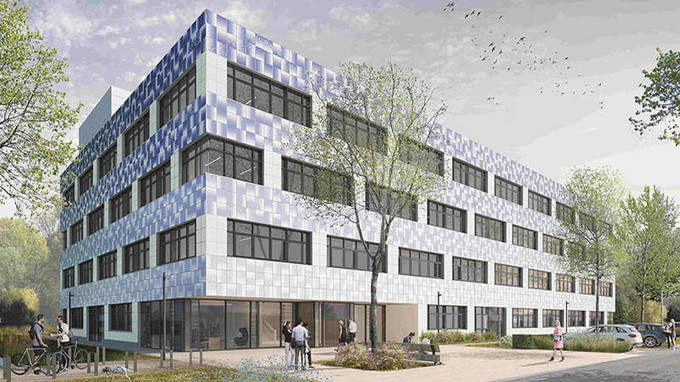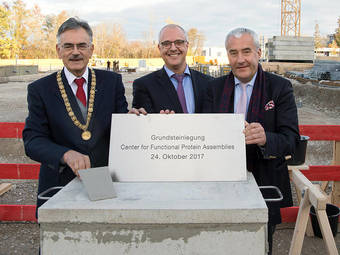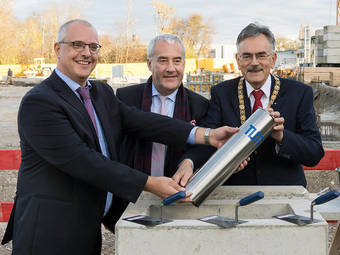Cornerstone laying for "TUM Center for Functional Protein Assemblies"
New protein research center on the Garching campus
2017-10-25 – Nachrichten aus dem Physik-Department

Human cells comprise a complex ensemble of biomolecules whose ordered interactions keep the organism alive and well. When dysfunctions occur, they can lead to serious diseases. Healing these kinds of illnesses requires a solid understanding of the fundamental principles of cellular functions.
Decisive in this quest are proteins, which are made up of long amino acid chains. Their functionality and spatial structure have long been the subject of research at TUM. Albeit, the complexity of most processes has only become researchable incrementally following recent methodological advances.
New (bio)medical applications

These dynamic protein interactions and the resulting functions will be investigated in the halls of the new research facility, which will offer some 4,400 square meters of research space spread across four stories. Physicists, biochemists and bioengineers will work in an interdisciplinary approach to research molecular and supramolecular mechanisms of action and to develop (bio)medical applications based on the results.
The CPA pools the expertise of its scientists and offers a range of large equipment as central technologies – like confocal optical microscopy, bio analytics and electron microscopy as well as X-ray crystallography. This infrastructure provided by CPA allows TUM wide collaborations – extending much beyond the members of CPA and their faculties.
The architectural office Carpus+Partner in Aachen are responsible for the planning. The metal facade of the building will take its form based on a design by the Rosenheim artist Rena Ina Rosenthal. The building grounds were conceived by the Munich office of Nowak und Partner. Because of the center’s supra-regional relevance, the construction costs of 40 million Euro will be shared equally by the German Federal Government and the State of Bavaria.
Pioneering concept for biomedicine
Bavarian Minister of Science Dr. Ludwig Spaenle: “The scientists of the Technical University of Munich have been doing excellent work in the field of protein research for many years. The TUM Center for Functional Protein Assemblies will provide the optimal framework to meet the challenges of research today and in the future. The construction will result in a research facility for which Bavaria and the German Federal Government will share the costs of 40 million Euro. That the Federal Republic of Germany is contributing to this research facility bears testament to the significance of the building within the national research infrastructure.”
TUM President Professor Wolfgang A. Hermann presented the integration of the protein research center within a comprehensive concept: “Our biomedical research will draw its future impetus from interdisciplinarity. The Munich School of BioEngineering provides the overarching bracket, associating protein research as well as the new Bavarian Nuclear Magnetic Resonance Center and, in the future, the Multiple Sclerosis Center funded by the Tschira Foundation in the vicinity of our medicine.”
As a so-called integrative research center, the TUM Munich School of BioEngineering will provide the shared teaching and research platform for all relevant activities of the various faculties, including the medically relevant fields of engineering and informatics. A wide array of cooperations with professors in Garching, Weihenstephan and Straubing extends the concept in the direction of biotechnology.
The founding director of the CPA, the biophysicist Professor Andreas Bausch, emphasizes the great support by the Bavarian government, the German federal government as well as the administration of TUM. “The building will host about 200 researchers from different fields, working on the exciting question of how proteins act together. Ultimately we would like to understand, how the interplay of different proteins leads to the workings of life.”
Participation of the Physics Department
These research groups from physics are involved at the CPA:
| Professor | Research group |
|---|---|
| Prof. Dr. Andreas Bausch, Director CPA | Cellular Biophysics |
| Prof. Dr. Matthias Rief | Molecular Biophysics |
| Dr. Zeynep Ökten | Biophysics |
| Prof. Dr. Martin Zacharias | Theoretical Biophysics |
| Prof. Dr. Ulrich Gerland | Theoretical Physics |
